
LifeHacker has a great article on how to automatically donate a portion of your Amazon Purchases to pro-abortion organizations, so I thought I’d share it with a little help for those of us disgusted by the killing of babies and want to help women and children in need out.
If you’re an Amazon customer and you’re disgusted with the onslaught of [babies], you can set your account to directly support [pro-life] organizations.
Through Amazon’s “Smile” program, you can choose from more than a million non-profit organizations that are qualified to receive a portion of Amazon’s sales in support of their mission.
The AmazonSmile Foundation donates .5% of the purchase price from eligible orders (that’s 50 cents for every $100 you spend), which admittedly is not much. But it does add up; Amazon reports that charities have received nearly $125 million, as of February 2019.
To set up your Smile account, go to the “Accounts and Lists” drop-down menu on Amazon’s homepage and then click “Your AmazonSmile.” From there, you can’t browse a full list of charities, but you can search for an organization to support by entering its name in the search field.
If you are in the Saint Louis area, I highly recommend searching for “Mosaic Pregnancy & Health Centers” in Granite City, Illinois, a great local organization that helps women.
When you’re placing an order, eligible products will be marked “Eligible for AmazonSmile donation” on their product detail pages. For your order to count, you have to place it through smile.amazon.com rather than the regular Amazon homepage.
Go make a difference and support women and children in tough situations.
Permalink
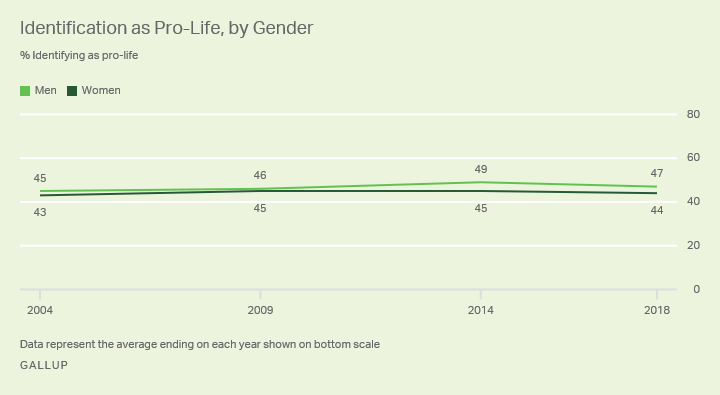
Many U.S. political leaders may think of abortion as a key “women’s issue,” but it is not an issue about which women have substantially different attitudes than men.
Gallup, June 2018
44% of women identify as pro-life. Look at the comment threads on major news pages and you'll see just as many women as men speaking out against abortion and in support of these recent heartbeat laws.
Gender is not an indicator of whether one will support abortion or not. Worldview is. Religion is.
Don’t let the talking heads stir up a division that doesn’t exist.
Permalink
This morning I’m reading more about our neighbor state’s abortion bill, which passed the Senate last night. This part makes me so happy to see:
Other provisions in the wide-ranging abortion bill include a ban on abortions based on race, sex or a "prenatal diagnosis, test, or screening indicating Down Syndrome or the potential of Down Syndrome."
KMOV
Outlawing the systematic eradication of children with Down Syndrome is one of the most appalling things going on in the US. We literally have tests early in a pregnancy to detect potential “defects” that then the doctors use to persuade mothers to kill their children. This bill outlaws that practice. I couldn’t be happier.
Permalink
Seeing the outrage reminds me of how outraged individuals were over losing the right to own slaves.
A lawless president has inspired lawless legislatures. Our laws are crystal clear the government cannot come between a [man] & [his property].
[This] will cost Alabama [men] their [livelihood], and threatens the [property] rights of [men] across the country. We must fight back, and our next president must act to enshrine [slavery] into law.
57% of voters think [slavery] should stay in place, poll says
CNN
You know what? Sometimes the law is morally wrong.
Slavery was legal. 100%. No question. It was legal. But it was morally wrong. So we fought to overturn that and free slaves to give them the same rights we held to be self-evident.
Those are the same rights that the unborn have. Not the same rights they deserve, not the same rights they will one day get: the same rights that they have. We are infringing on their pre-existing— not made-by-the-government— rights. Just as we were the slaves. Exactly the same.
Permalink
Fewer words and more intentional questions go a long way in conversations and debates.
In both, conversations and debates, your intent should be to understand one another.
In a conversation, you want to understand one another so that you are not in disagreement and you get closer.
In a debate, you want to understand one another so that you can find what you disagree on and lay a persuasive argument.
All too often I see online debates and conversations starting with assumptions and arguing from there. Often wordy, long-winded, hard-to-follow exaltations. Sometimes the assumptions are right, but usually, they are simply strawmen. An assumed position for your opponent.
The foundation of debate is the definition of terms. Without an agreed-on definition, one can— and often does— disagree semantically and think they are disagreeing on the topic.
So my recommendation: Use fewer words and ask more intentional questions. Understand one another first. You cannot disagree with what you don’t understand.
Permalink
Let’s start with something that no one can argue with. If I know all the variables going into an equation, I can know the outcome. This is an undeniable truth.
Could you imagine if you dropped a ball and instead of falling, sometimes it went straight up? No, no you couldn’t. The universe follows logical patterns. Outcomes are predictable and reproducible.
Sweet, let’s touch the touchy argument. Are people predictable?
We learned in grade school that everything works off cause and effect. Do people? Of course they do, says science. But philosophically, we desire to inject "free will" into the equation, don’t we?
I walk into a room. Three doors are in front of me. I must choose one. Can someone predict which one I’ll choose? Not easily. Now, if the doors are decorated with things and one is decorated in a way I am known to prefer, and I am a trustworthy person that doesn’t expect it to be a trap, I might have a high likelihood of choosing that door. But what if they are all just plain wooden doors? And I don’t believe in numerology. And I wasn’t coerced/lead to choosing a specific one.
I will always choose the one I choose. Why? Cause and effect. But what if a puppy is in the room? That’s a new variable. I might choose a different one. Given the same equation and the same variables, we can expect the same outcome.
But can someone predict which one I’ll choose? Only if they know all the variables.
Wait. So you are telling me that I don’t have free will?
No, that’s not what I said. Go back and read. I’ll wait.
You said I will always choose the one I choose! That means I couldn’t have chosen the other two doors. So I don’t have free will.
No, you do have free will. And you freely and willingly chose the door you chose. You were free to choose the others. You just never would have.
Free will is perception. I don’t get caught up on the term, personally, but others do. It is perception. Are you making a choice? You feel like you are, so I’d say you are. But the outcome is determined by all the variables going into the equation, so you are making an ultimately logical choice.
If your brain hurts or you need to have an existential crisis, take five minutes to breathe.
Application
People are totally depraved. No one is capable of good. This is a basic Christian premise. If you disagree, I urge you to press on. Only part of what I want to say has to do with very Christian concepts. That is one of them. If it makes you feel more comfortable, let me put it this way: within evolutionary science, the claim is made that all things we do are for survival. Survival of ourselves and survival of our species. If that is so, we are making all decisions, even good ones for selfish reasons. Better? Okay, let’s continue.
It would be correct to say that people are capable of all sorts of evil. It would be incorrect to say that all people are capable of all sorts of evil. One word difference, but massive implication difference.
So why? See point number one.
Are all people capable of all sorts of evil? What does that mean? Grab a sampling of people. Random— which is impossible because of point one, but I digress. Okay. Are all these people capable of all the same evil? No. That guy over there is capable of murder. So is that gal. But not the rest. Those three are capable of rape. But not the rest.
Note the tense. Capable of. Present tense. I cannot speak to the future. We can make predictions, but outside of a controlled environment, we cannot predict what variables will change the individual's character— an effect— that can lead to the capability of evil they are currently incapable of. With me? I’m not predicting the future. Only the present. Okay.
So why are these people capable and these people are not. Point number one was that everything is cause and effect. If we can know every variable going into an equation, we can know the outcome of the equation. Right? And people are ultimately predictable. They just are.
But only if you know all the variables.
Okay, so we know why these people are capable and these people are not. Based on their lives up to this point, through the course of billions, maybe trillions, of causes and effects, they are where they are. They can make no choice but the one they can make.
Please stop squirming. I gave you enough time to have that existential crisis earlier.
The real questions are how do we know which are capable and which are not. We are not omnipresent and omniscient. We are not everywhere and we don’t know everything. True. Can we know?
Character and Integrity
People are remarkably consistent. As one can assume based on what I have said thus far. But you know this from your own life. Your best friend is nearly predictable. You can finish each other’s sandwiches. You are seldom surprised by their actions and reactions.
Why? Don’t they have the free will to do the completely unpredictable? Okay, I’m picking on you. Free will is a lie.
But you see it don’t you? Why is this? Character and integrity. Character is the attributes and features that make up an individual. Integrity is their level of consistency with ethical and moral positions. Over time, the closer we get to someone, the more we learn their character and integrity. They become less spontaneous and less random. Because they never were.
And as we learn about and become closer to them, we can— with more and more confidence— expect their reaction to certain situations. I can ask you if you were stuck in a specific scenario, who would you want with you.
So can we predict what evil they are incapable of? Yes, with high probability, the closer we know them. Why? Because we know more and more of the variables.
Total Depravity
It would be correct to say that people are capable of all sorts of evil. It would be incorrect to say that all people are capable of all sorts of evil. One word differences, but massive implication differences.
Is my best friend capable of evil? Yes, of course. But all sorts of evil? No. I know her better. I could have missed something. Or she could have been hiding something. Or I could just think the worst of people. But my perception doesn’t change the variables.
Believing that some people— maybe most people— are not capable of a specific evil doesn’t go against total depravity. It fits with everything we know about the universe.
But only if we know people can we see this. We can only know someone if we get to know them. And only if we build into people can we change the world.
Permalink
The difference between a half-assed app and a kick-ass app comes down to execution. Many apps try to be too many things at once— hey, have you thought about adding a tuner?— or packing in too many features too quickly. For Selah Chords to have that hand-crafted, well-executed look I wanted, I need to punt features.
When you are building an app, you have to define the MVP— the Minimally Viable Product. What is shippable? But, sometimes during development you reach a point that the product is shippable before you hit what you thought was your MVP. That happened with Selah Chords.
The initial MVP included Custom Tunings. The ability to add, edit, and delete tunings and instruments. Why? Because that is what the engine, the algorithm, was built to do. Give it a set of strings— and a couple parameters— and it would find chords. But once I had the interface for switching chords, scrolling through voicings, and the beautiful themes all in place I realized something. I could just load up a set of default instruments and tunings and ship it. Everything else was ready to ship, but to add Custom Tunings would take another month at least.
So I punted Custom Tunings. It made sense. It was still a very important feature to me, but not for the 1.0. And, as it turned out, not for the 1.1 either. Version 1.1 came with favorite chords, copying chord voicings, drag-n-drop, and banjo support.
You must, when you are building an app, have the goal of shipping. You can always ship an update. Ship early. Ship often.
Permalink
I removed the ads from Selah Chords. As I developed Selah Chords, I knew I needed to try something new with the purchase strategy. Where Web Tools is a pro app for iPad, Selah Chords is targeted at a crowd with many free— albeit not great— options. So I baked in ads and a "Remove Ads" in-app purchase.
And it bombed. In a month and a half of availability, I have made 75 cents on ads and had just 2% of users pay to remove ads.
Here's the thing. You must annoy the shit out of your users to get them to see the value of removing ads. Think of any game you have played recently. You are mid-game and POPPPPP! A full-screen, full-volume, full-video ad. For 30 seconds you must wait to play again. And after the umpteenth time, you buy the in-app purchase to stop that shit.
That's called a "dark pattern" in the UX world. And I hate it. So I just had a simple ad at the bottom of the app. And it didn't annoy anyone. So why pay to remove it.
So I have removed the ads from Selah Chords.
GDPR
Don't get me started on the small-government train here, but GDPR prevented me from launching in Europe. Why? Because the laws are unclear and very threatening for an indie shop. If I screw up even a little, I could be fined for potentially millions. So instead of trying and failing to follow a new law in Europe, I blocked Europe.
Europe
Selah Chords is now available for Europe! Because I removed ads. So now— as I have no server-side API use, no tracking, no privacy-invading anything— I don't have to worry about GDPR.
Free, but an IAP
Selah Chords is still free to download and use, but beyond the launch features— the best, most easy to use chord finder, with guitar, ukulele, mandolin, banjo, and dulcimer support— you will need to pay to unlock the full app. Right now, that means Custom Tunings. Next up is additional chords. And other features are in the pipeline.
If you wish to support further development, please buy the IAP for $5. That's a coffee.
Permalink
You can turn a bunch of great ideas into a crappy product real fast by trying to do them all at once. You just can’t do everything you want to do and do it well.
Rework by Jason Fried and David Heinemeier Hansson
Half-assed products abound. Sometimes it’s simply a lack of quality. Often it’s something else.
When we think of a product, we usually think of it’s features. How many features? What features? Et cetera. If you haven’t built a product before, let’s do a quick thought experiment.
I tell you that you have two hours to clean the house. You have toddlers. That are home. And awake.
How much got done in that two hours?
Now I tell you that you have two hours to clean the kitchen. Same toddlers. Still awake.
How well did the kitchen get cleaned in each scenario? I bet the kitchen was a lot more clean in the second scenario.
Cut your ambition in half. You’re better off with a kick-ass half than a half-assed whole.
When we pare down our tasks, we do better at accomplishing them.
Same goes with product design. When I started building my chord finder app last year, the feature list was long. The competition had tuners, metronomes, and even song sheets. But those features never once hit my list. Because I couldn’t create a kick-ass chord finder if I was building a tuner. I’d end up with a half-assed chord finder. And a half-assed tuner.
But I did have other features on the list that didn’t ship with version 1.0. They didn’t ship with 1.1 either.
Most of your great ideas won’t seem all that great once you get some perspective, anyway. And if they truly are that fantastic, you can always do them later.
As you build, you will often get to a point that the product is complete. And sometimes it will surprise you. A feature you thought essential wasn’t. A feature you thought wasn’t essential was. If you prioritized your tasks well, you didn’t build the inessential features.
But the beauty is, you can always add them later.
Selah Chords will never have a tuner. That is a different product. Selah Chords is about chords. But coming to Selah Chords early this year is custom tunings, filtering, and more.
I build kick-ass half— not half-assed whole— products. Download Selah Chords today and see what a great, easy-to-use, hand-crafted chord finder can be.
Permalink
Early this year I started playing with an app idea that became Selah Chords. I had a working prototype of the engine that would power it. I knew it could work. But what would differentiate it would be care for UI. Make it easy to do the things that needed to be easy. Instead of focusing on all the other tools that could be added— literally, the competition nearly includes the kitchen sink in their apps— I would focus on doing one thing really well.
A recently (at the time) published article from Michael Flarup had me encouraged to explore skeuomorphic design again, something I had been itching to do for years. To be honest, app design today is too bland. Most of us know that. It used to be full of texture and UI work, parts of the process that would take months. Each app had personality. Then iOS 7 happened. And all that work got thrown aside. Read that article.
I explored a number of paper, notebook, and other interface metaphors for Selah, trying to find a voice that could work. And in the end, I could not find a voice there. And the reason was because I wanted to rely on the screen, not the physical world’s physics.
I had one major interaction that needed to be nailed, in my opinion. Finding a chord. Seems easy, I know. But everyone makes the easy hard, for some reason.
This is a great app. I honestly use it quite a bit, as it supports chords that Selah Chords does not support. But finding a chord in Guitar Gravitas sucks. First, the root note selector is a slider. Second, the selected state is a dotted, 1px tall underline. This thing is horrible.
Then there is the scroll direction change in finding a chord. This app uses multiple panels that all scroll independently. This is not an iOS convention and instantly feels off. Mind you, on iPad, this is better because of the screen size.
The biggest reason that I use this app regularly, as opposed to others, is because of the chord charts. It shows me tons of voicings without the trouble that other apps make of that.
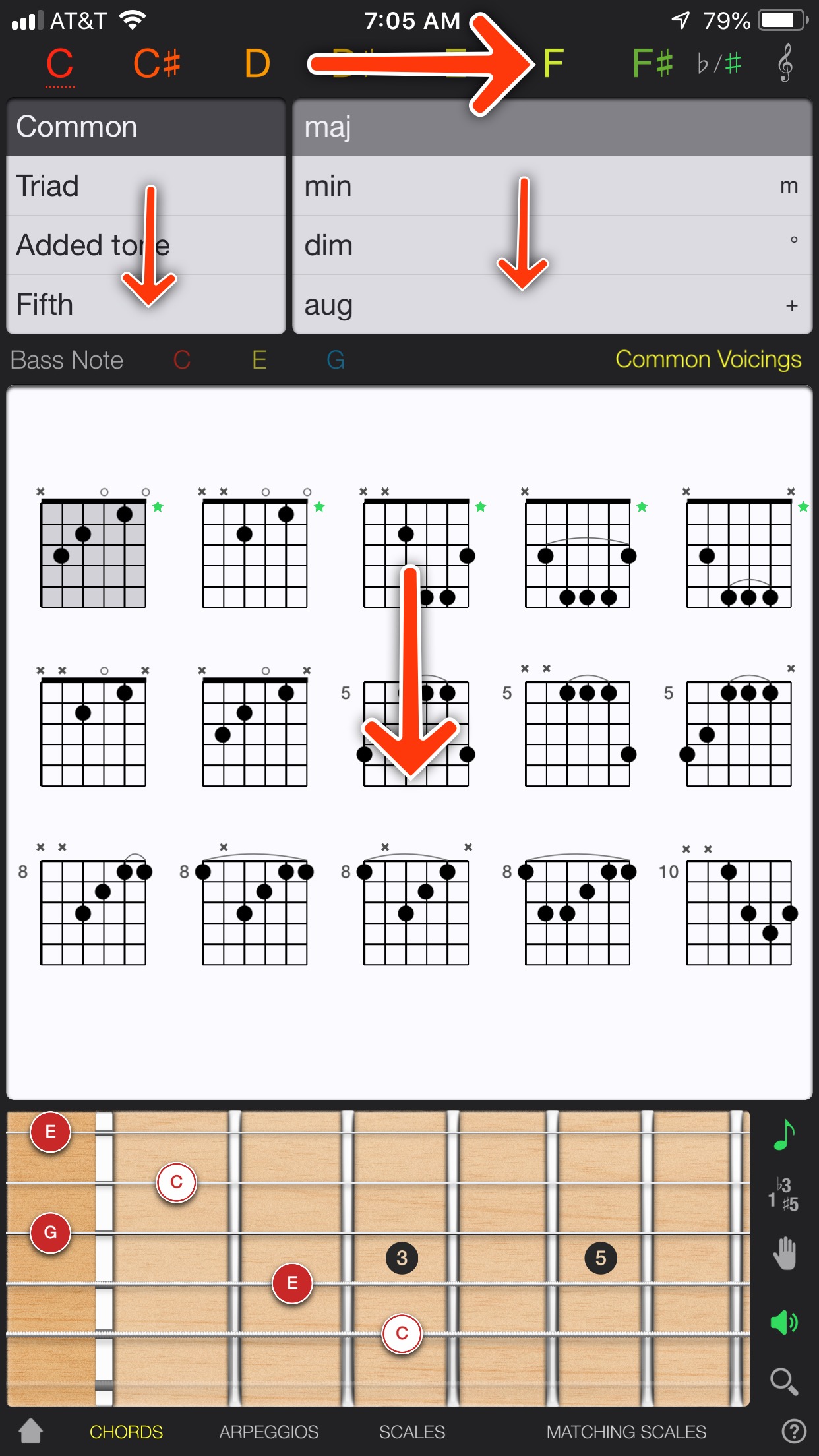
One of the most popular guitar apps, as it is a tuner— a pretty good one— that also provides other tools. Personally, if you want a good tuner, get Fine Tuner, but that is a different topic. The chord library tool is what we are focusing on here. Once again, sliding lists for root and chord, but made worse by the scroll for voicing. Guitar Tuna only provides a handful of voicings— standard movable shapes, essentially. But to see them, you have to flick one-by-one through them.
I do not use this app much. Mostly because the interface is less than ideal.
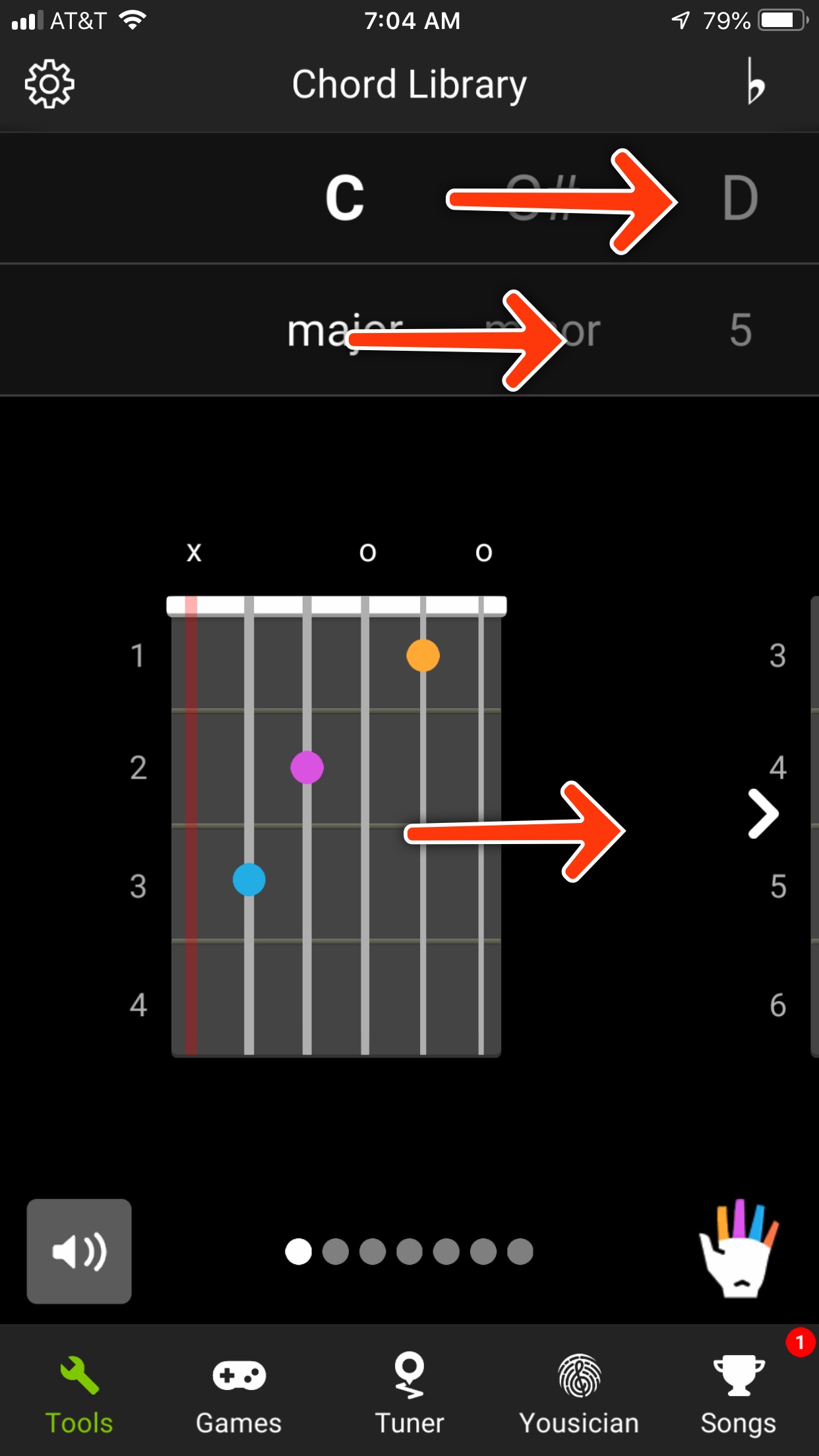
Another popular guitar app. Tuner? Check. Metronome? Check. Scales? Yup. And chords. That root note selector is better. All on one screen. No scrolling. But now to select a chord, you have to find it in a scrolling collection view— rows and columns— and expand it.
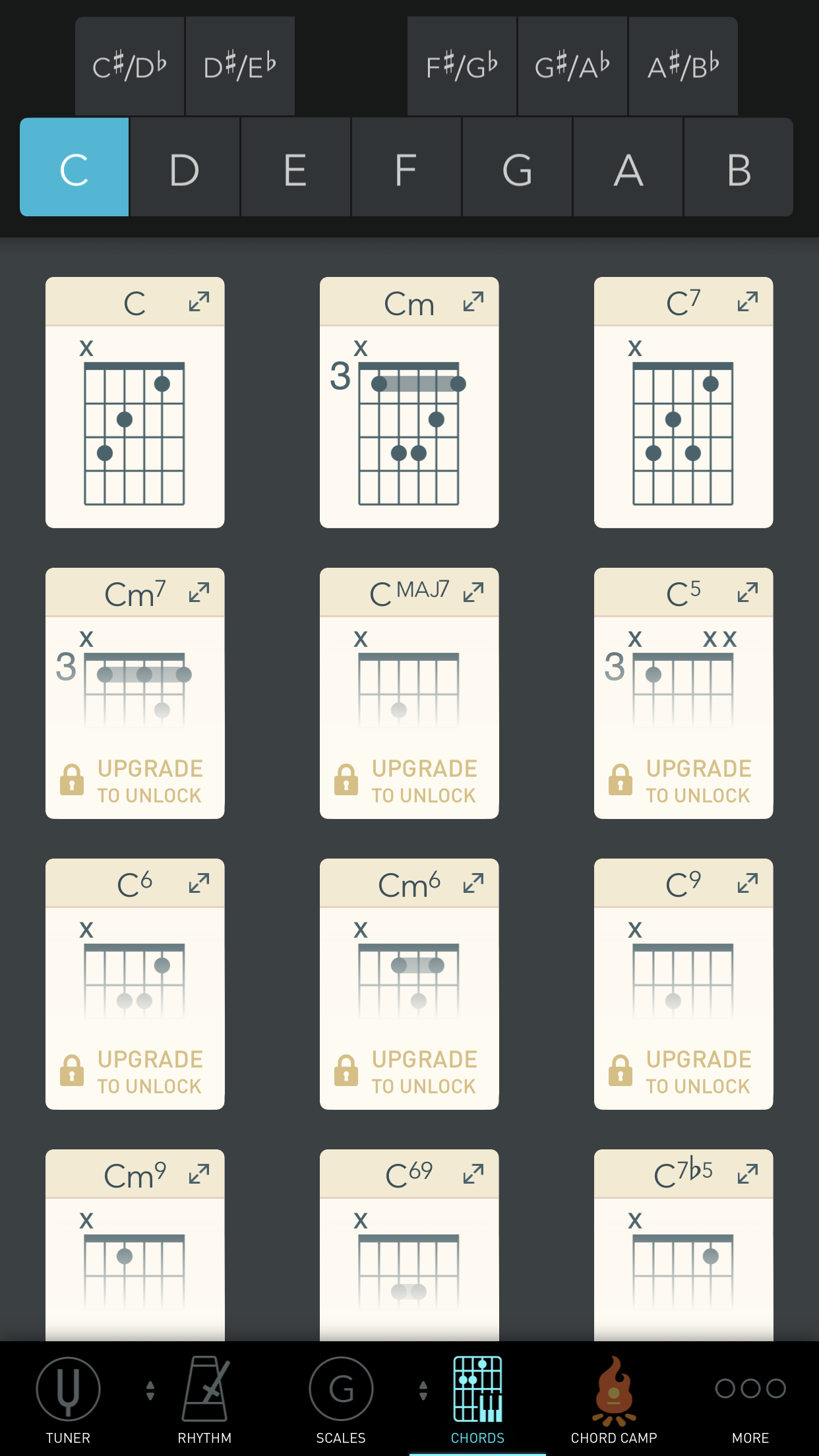
Wait, don’t tap— damn. It just played the chord. You wanted to see more voicings, didn’t you. Yeah, tap that small expand icon. And now, when the collection would have made since, you get this scrolling list of voicings and a guitar neck that takes up two-thirds of the screen.
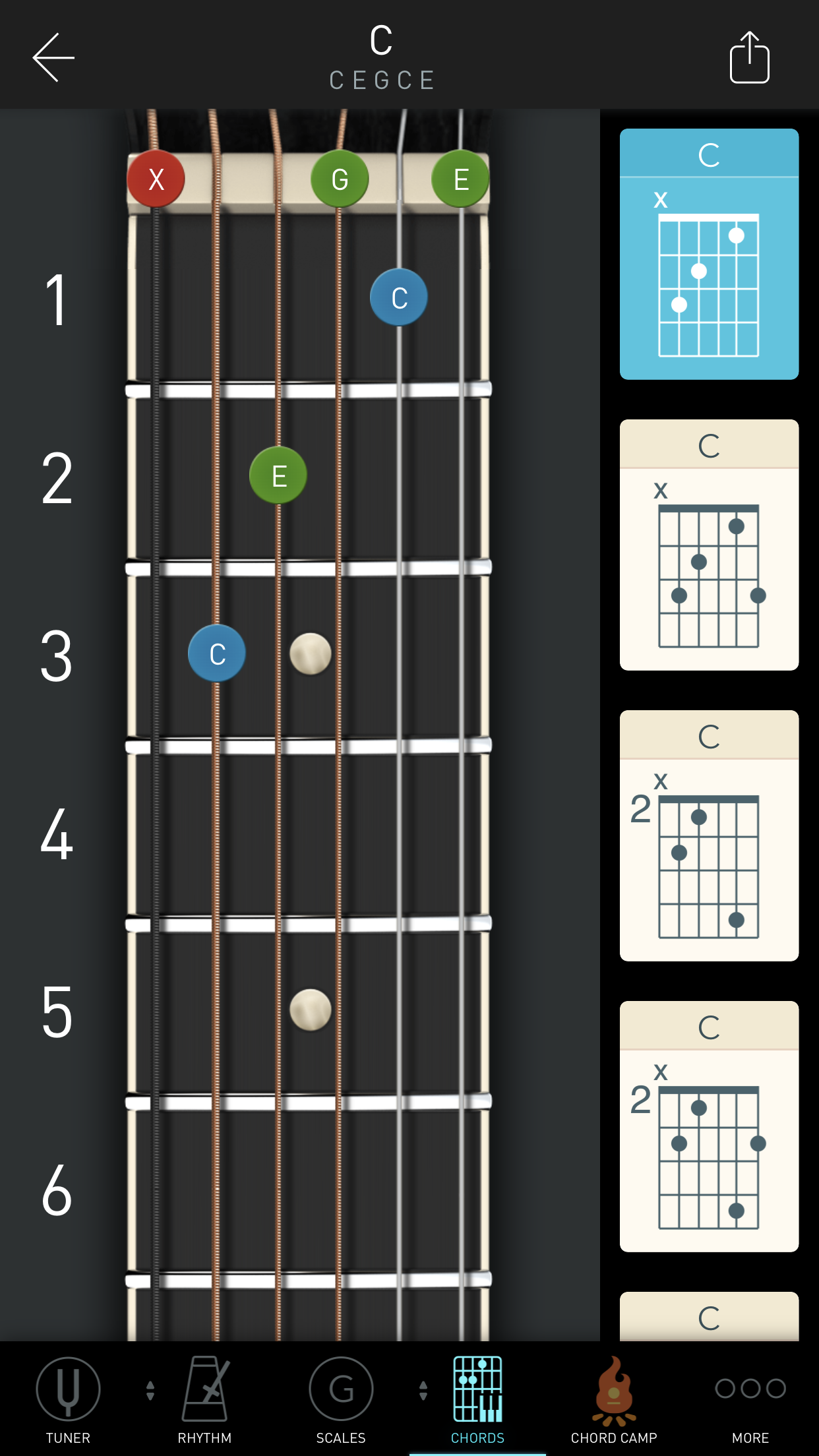
Finding my Voice
As I looked to solve this one interaction, Jared Sinclair shipped ’Sodes. And boy. While not skeuomorphic, while super minimalist, it wasn’t boring. It wasn’t bland. Subtle gradients, sparse, well-thought our content layout design. The content was king, not the interface. But even without the interface being king, it didn’t get so far outta the way that you were confused. Buttons had borders. They looked like buttons.
So instead of making beautiful, meticulous textures, I started storyboarding animations. The first test of what I deemed gooey animation was built.

Instead of sharps getting their note name repeated, the sharp extended the preceding note button. The construction under the hood is fun, taking accessibility into consideration with an accessibilityLabel of the full name (“C#”).
And then the sliding selection. Clear selection state was important. At this point I was using Guitar Gravitas and that was my biggest grievance. Animating this allows for a fun, hand-crafted interaction, while not getting in your way. This is done by making the animation quick and informative.
The chord selector is brief. I didn’t need to support a hundred chords. Why? Because the most common chords can be summed down to a handful. I’m not looking to build the only chord finder you use, just your favorite.
Is Skeuomorphic Dead, Then?
I hope not. What I know is that it wasn’t right for Selah Chords. Which surprised me at first. I wanted it to be right. It might be for your app.
What’s Next?
Banjo support is coming. Selah Chords started with guitar, ukulele, mandolin, and dulcimer. I am adding banjo. Also copying or dragging voicings out of Selah Chords is coming. And favorite voicings. And who knows what else.
Get Selah Chords today. It’s free and will become an essential part of your musical toolkit.
Permalink






